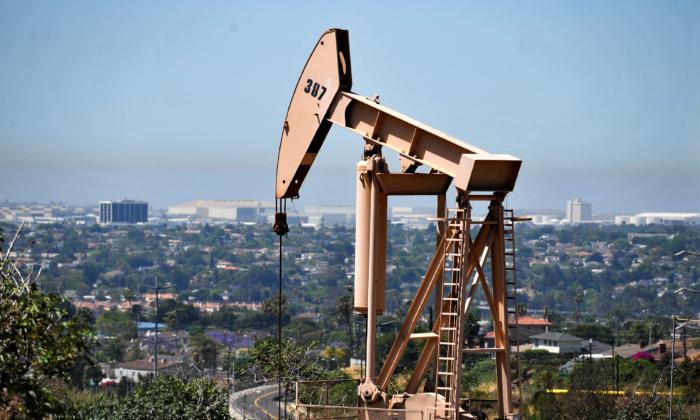Domestic oil production in the United States hit an all-time high of more than 13 million barrels per day this month for the first time in over three years, after plummeting during the early stages of the COVID-19 pandemic, according to the U.S. Department of Energy (DoE).
However, experts claim the bolstered production is a result of past policies.
In an Oct. 12 update from the DoE’s Energy Information Administration, officials said oil production in the first week of October hit 13.12 million barrels per day (bpd), up from 300,000 bpd from the previous week and far surpassing the previous record set in March 2020, just before the COVID-19 pandemic, of 13.1 million bpd.
The Energy Department also projects that oil production will rise by 1.01 million bpd, to 12.92 million bpd, in 2023, and by 200,000 bpd, to 13.12 million bpd, in 2024.
The new data come as Republican lawmakers have continued to put pressure on the Biden administration to bolster domestic oil production in response to soaring price and energy security concerns, prompted in part by Russia’s invasion of Ukraine, which upended the market.
After taking office in 2021, President Biden canceled the Keystone XL pipeline and issued a moratorium on all oil and natural gas leasing activities across various U.S. lands and waters, leading to further criticism from Republicans.
More recently, President Biden announced he will sell just three offshore oil and gas leases over the next five years, marking a sharp contrast to former President Donald Trump, who planned to hold 47 offshore leases from 2022 to 2027.
Climate Change Groups Call Out ‘Hypocritical’ Actions
Still, production in some regions of the United States such as the Permian Basin in Texas and New Mexico—the biggest U.S. oilfield—hit a record 5.83 million bpd in June, although production is still significantly down in areas such as Oklahoma and North Dakota, according to reports.While the new historical oil production figures will likely be welcomed by Republican lawmakers, they also appear to be at odds with President Biden’s climate goals—the president has vowed to slash carbon emissions to zero percent by 2050.
The latest data were not welcomed by all.
“Continuing to expand oil and gas production is hypocritical and not at all consistent with the global call to phase down fossil fuels,” climate scientist Bill Hare, CEO of Climate Analytics, a climate science and policy institute supporting climate action aligned to the 1.5°C warming limit, told the Associated Press.
“The U.S. support for expanded fossil fuel production will undermine global efforts to reduce emissions,” Mr. Hare added.
Despite President Biden’s stringent climate goals—largely shared by leaders in the European Union—in its outlook for 2023, the Energy Department also noted it anticipates global carbon emissions will rise through 2050.
While climate change activists opposed the increase in domestic oil production, others were quick to note that the latest data, while a welcome change, was not, in fact, a result of President Biden’s actions.

‘Wrong to Credit President Biden for Oil, Natural Gas Production’
Amanda Eversole, who serves as executive vice president and chief advocacy officer at American Petroleum Institute (API), the largest U.S. trade association for the oil and natural gas industry, noted in an opinion piece for The Washington Post that the current U.S. energy supply is largely a result of previous policies and not attributable to the Biden administration.“Focusing on current energy supply considers only the final stages of oil and natural gas production that started years earlier. From exploration to refining, turning oil and natural gas into everyday products takes time. For offshore oil and natural gas leases, it can be up to 10 years from development to operation,” Ms. Eversole wrote in the Oct. 13 op-ed.
“Those leases can and often do produce for years, if not decades,” she added. “Thus, it’s wrong to credit President Biden for oil and natural gas production that started before his term.”
“It’s easy to play down these energy realities amid headlines about record U.S. production. But years from now, if—as predicted—oil and natural gas demand has risen and there isn’t enough supply, the Biden administration will bear the blame,” she concluded.
In addition, the latest Energy Department data were not all good news: gasoline stockpiles fell by 1.3 million barrels, to 225.7 million barrels in the week ended Oct. 6.
Meanwhile, the number of rigs in operation at U.S. fields has also dropped this year, with data for the week ended Oct. 6. showing the rig count fell to 497, the lowest since February 2022.
The latest data come shortly after Russia and Saudi Arabia agreed to extend their voluntary oil production cuts of 1.3 million bpd through the end of this year, pushing up energy prices again. The cuts appeared to defy President Biden’s threats last year that the kingdom would face unspecified “consequences” for partnering with Russia on the oil cuts.







